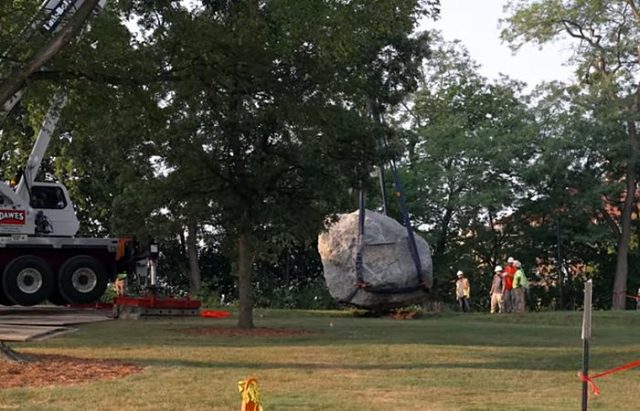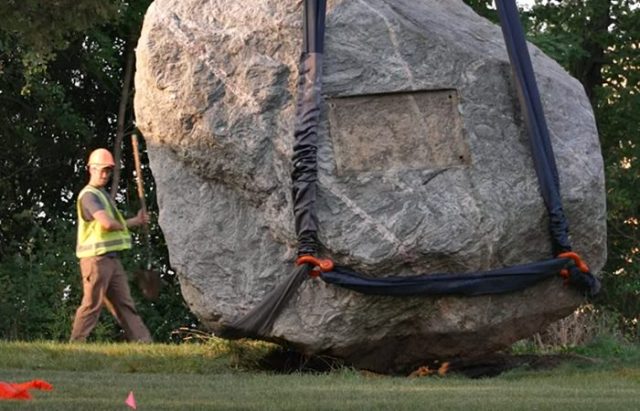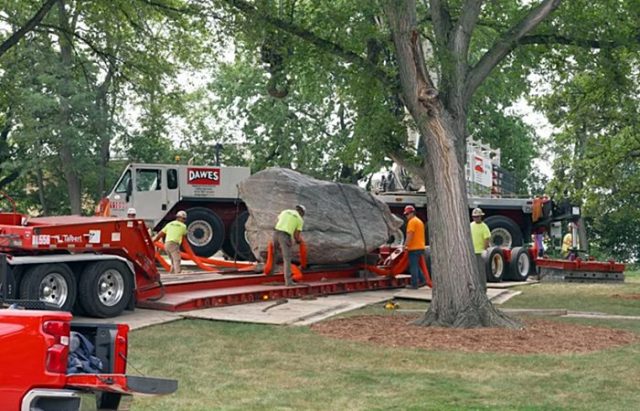Tears of joy were shed as black college students watched crews remove a 42-ton boulder from campus. Students had fought tirelessly to have the rock banned, calling the rare geological relic from the pre-Cambrian era a symbol of “racism.”

Several race-based student groups celebrated their year-long effort to have a “racist” rock removed from campus after the hunk of granite was finally hoisted away from its historical resting place. The University of Wisconsin-Madison is 84,000 lbs lighter after the stony offender was hauled off to an area far away from fragile eyes.
The boulder, which sat on the campus for almost 100 years, become the target of ire of the Black Student Union and Wunk Sheek, an indigenous student group. Although the fixture was identified as “Chamberlain Rock” after the former university president and geologist Thomas Crowder Chamberlain, students were upset to discover it was given a controversial nickname.

The students’ outrage stems from a 1925 Wisconsin State Journal article in which the author referred to the boulder as a “n——-head” rock, using the slur to describe its dark appearance. Although university historians couldn’t find any other time the slur was used to describe the boulder, students were fixated on removing the rock.
Scientists placed the formation of the boulder during the pre-Cambrian era, which is calculated at more than 500 million years ago. Still, the student groups were adamant that the geological wonder had to go because one person insensitively referred to the rock by an offensive name a century ago.

Spearheading the boulder’s removal were Black Student Union president Nalah McWhorter and student activist Ayomi Obuseh. The young women expressed their determination to get the stone taken off-campus, no matter the cost.
“You clearly see what the rock was called and you can’t deny the history. Additionally you can’t deny the way it makes some people feel,” Black Student Union president Nalah McWhorter told Madison.com. “If you’re not going to move the things that are disrespectful to us because other students love it, put something up that us Black and brown students can celebrate.”
The students lauded their efforts, equating the removal of the rock to a monumental stride in civil rights.
“[We] hope that this is a symbol of change, a symbol of a start to a new beginning,” student activist Ayomi Obuseh said. “It means so much for myself but it means something to everybody that’s been advocating for it’s removal. It’s showing that our hard work isn’t going to waste, that if we keep pushing forward, change can come and we’re seeing that with events like today.”

It required a whopping $50,000, several crews, and a crane to remove the stone. The university confirmed that the money came from the “Chancellor’s Office” and not taxpayer funds.
Chamberlain Rock was transported to a publicly accessible plot of land owned by the university southeast of Madison near Lake Kegonsa. It will be used for educational purposes by the geoscience department likely until one of those undergraduates finds it too painful to study.

Donors and potential applicants may be concerned that their money is going to fight racist rocks and chasing the racist ghosts of the past. Sadly, the money spent on removing a chunk of nature to preserve the hyper-sensitive feelings of fortunate young adults could’ve helped a less privileged individual obtain higher education.
Instead of strengthening young people and equipping them to persevere in the real world, universities are feeding their inflated egos and enabling their fragility. Although they see themselves as akin to the heroes of the civil rights era, they are nothing more than privileged authoritarians tilting at windmills.







